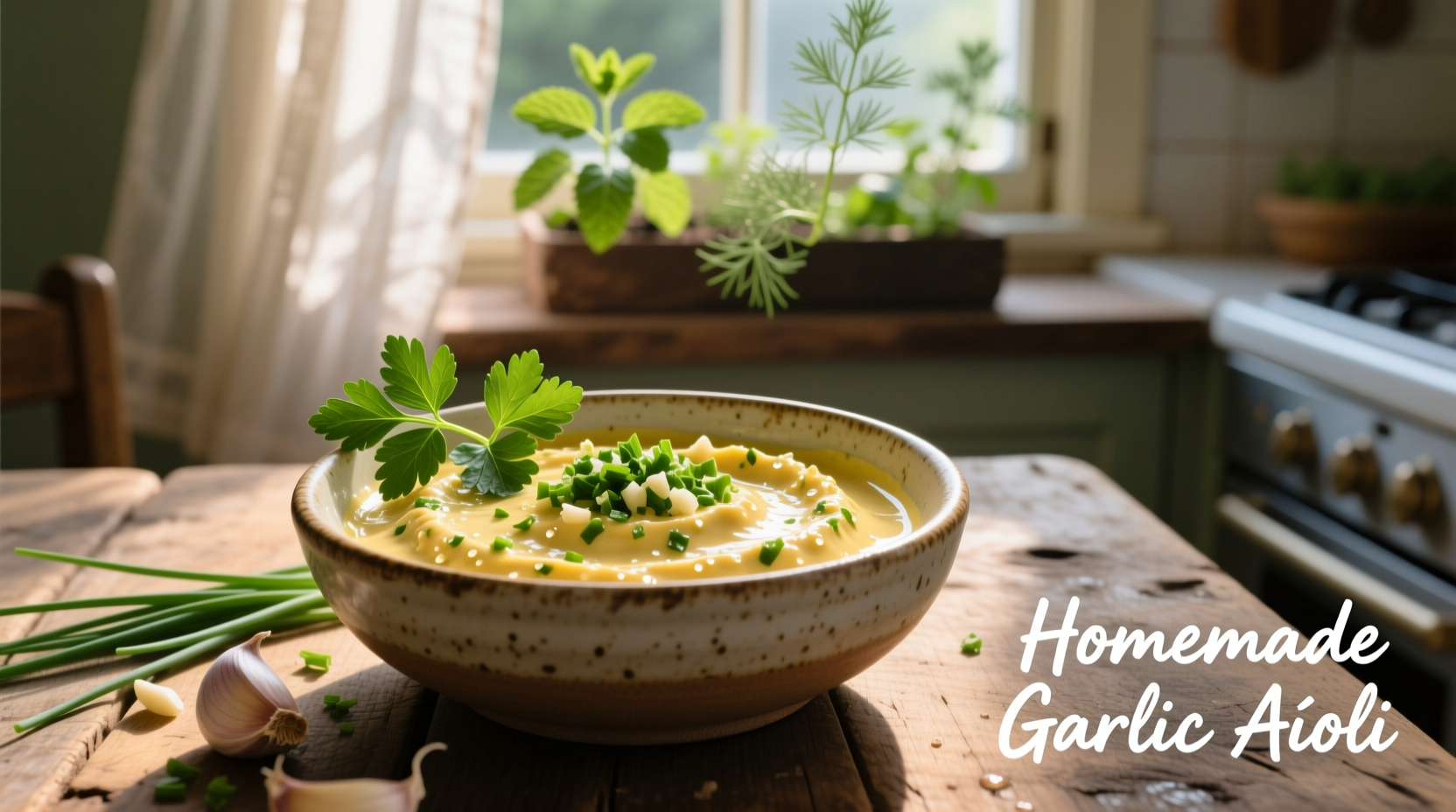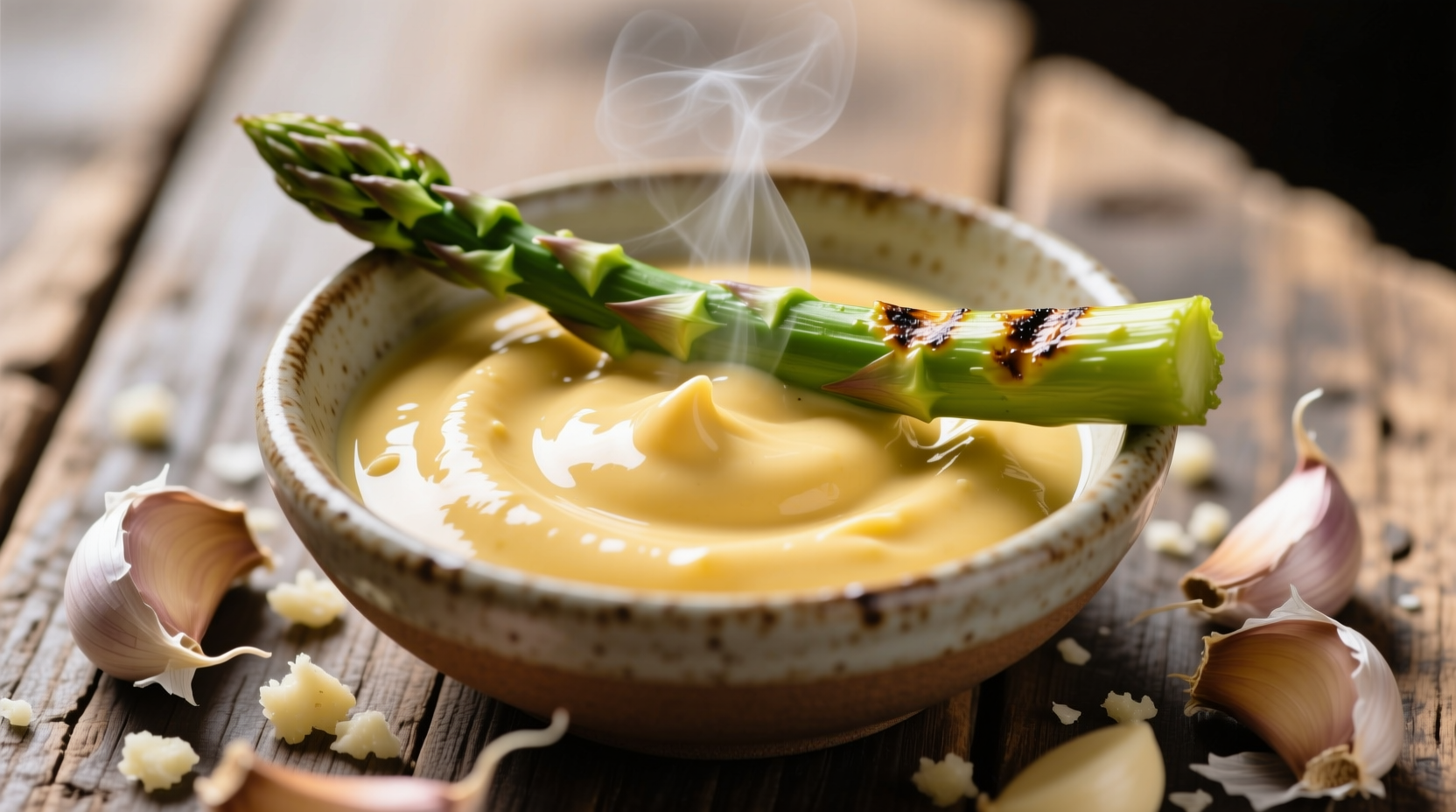What Exactly Is Garlic Aïoli? Beyond the Mayonnaise Myth
Despite common confusion, authentic garlic aïoli bears little resemblance to commercial mayonnaise. True aïoli (from the Catalan alli for garlic and oli for oil) originated in Mediterranean coastal regions as a simple emulsion of crushed garlic and olive oil. The French Provençal version later incorporated egg yolk for stability, creating the foundation for modern preparations.
Unlike store-bought alternatives loaded with preservatives, authentic garlic aïoli relies on three core components:
- Fresh garlic (never powder or paste)
- High-quality extra virgin olive oil
- Egg yolk (for traditional emulsion)
| Characteristic | Authentic Garlic Aïoli | Commercial Mayonnaise |
|---|---|---|
| Primary Emulsifier | Egg yolk + garlic paste | Egg yolks only |
| Fat Source | Extra virgin olive oil | Soybean or canola oil |
| Acid Component | Lemon juice (optional) | Vinegar |
| Flavor Profile | Garlic-forward, herbal notes | Neutral, tangy |
The Evolution of Aïoli: A Culinary Timeline
Understanding garlic aïoli's historical journey explains its regional variations and proper preparation techniques:
- Pre-Roman Era: Mediterranean coastal communities created primitive garlic-oil emulsions using stone mortars
- 1st Century CE: Roman moretum (herb-cheese spread) influenced early garlic-based preparations
- 15th Century: Catalan cooks documented salsa de allioli in medieval manuscripts
- 1800s: French Provençal version incorporated egg yolk for improved stability
- 20th Century: Industrialization led to commercial mayonnaise-based "aïoli" products
- Present Day: Culinary revival emphasizes traditional preparation methods
Mastering the Perfect Garlic Aïoli: Step-by-Step
Creating authentic garlic aïoli requires attention to technique rather than complex ingredients. Follow these professional chef techniques for foolproof results every time.
Essential Ingredients Checklist
- 2 large egg yolks (room temperature)
- 3-4 garlic cloves (fresh, not pre-minced)
- 1 cup extra virgin olive oil (high quality)
- 1 tbsp fresh lemon juice
- ½ tsp sea salt
- Optional: 1 tsp Dijon mustard for stability
Critical Preparation Steps
- Garlic preparation: Mince garlic finely and mash to a paste with salt using mortar and pestle (never skip this step)
- Emulsion foundation: Whisk egg yolks and garlic paste until pale yellow (2-3 minutes)
- Oil incorporation: Add olive oil drop by drop initially, then in thin steady stream while whisking constantly
- Consistency check: Stop when mixture thickens to mayonnaise-like texture (reserve 2 tbsp oil)
- Finishing: Whisk in lemon juice, then slowly incorporate reserved oil for perfect texture

Creative Variations Worth Trying
While traditional garlic aïoli shines on its own, these chef-approved variations expand its culinary applications:
- Lemon-Herb Aïoli: Add 2 tbsp chopped fresh parsley and 1 tsp lemon zest
- Roasted Garlic Version: Substitute raw garlic with 6 cloves roasted garlic for milder flavor
- Spicy Harissa Twist: Mix in 1 tbsp authentic harissa paste for North African flair
- Herbes de Provence: Incorporate 1 tsp dried Provençal herbs for French countryside flavor
Perfect Pairings: What to Serve With Garlic Aïoli
Understanding regional serving traditions ensures authentic flavor experiences while avoiding common pairing mistakes:
| Traditional Pairings | Modern Applications | Context Limitations |
|---|---|---|
| Grilled fish (especially cod) | Burger spread alternative | Avoid with strongly spiced Asian dishes |
| Roasted vegetables | Dipping sauce for sweet potato fries | Not ideal with delicate shellfish |
| Pa amb tomàquet (Catalan bread) | Salad dressing base | Overpowers subtle flavors |
| Grilled chicken | Marinade component | Not suitable for dessert applications |
Storage and Food Safety: Keeping It Fresh
Proper storage is critical for both flavor preservation and food safety. The USDA Food Safety and Inspection Service recommends these guidelines for egg-based sauces (source):
- Refrigerate immediately after preparation
- Store in airtight container for up to 3 days
- Never leave at room temperature more than 2 hours
- Discard if separation becomes permanent or odor changes
For extended storage, consider making a garlic-infused oil first, then preparing aïoli fresh when needed. This technique, documented in the University of California Cooperative Extension's food preservation guidelines, significantly reduces food safety risks while maintaining flavor (source).
Troubleshooting Common Aïoli Problems
Even experienced cooks encounter issues with emulsions. These professional solutions fix common problems:
- Broken emulsion: Start new bowl with 1 tsp water, slowly whisk broken sauce into it
- Too thin: Whisk in additional 1-2 tbsp olive oil gradually
- Overpowering garlic: Balance with additional lemon juice and olive oil
- Bitter taste: Caused by low-quality olive oil - always use fresh, high-grade oil











 浙公网安备
33010002000092号
浙公网安备
33010002000092号 浙B2-20120091-4
浙B2-20120091-4